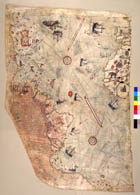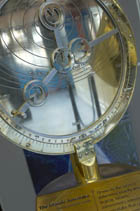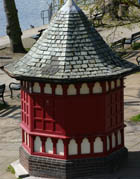
Did you know that nearly every medical book by Muslims a thousand years ago covered some aspect of eye diseases?
Muslim ophthalmologists of the 10th to 13th centuries were performing operations, dissecting, discovering, and writing about their findings in textbooks and monographs.

Piri Re’is, a Turkish captain, created a map in 1513 which has come to be known as the famous ‘Map of America’.
This astonishing map clearly shows Antarctica, as well as the Andes Mountains of South America. Both of these were ‘first seen’ years after this map was created in 1513

Zheng He was a Muslim who helped transform China into the regional superpower of his time.
Within 28 years of travel, he visited 37 countries in the course of seven monumental sea voyagers. Zheng He sailed throughout the Indian Ocean decades before Christopher Columbus or Vasco de Gama and with ships five times bigger.

A major breakthrough in communications occurred in Baghdad under the ‘Abbasid Caliphs.
Carrier pigeons were used as a postal service. It is mentioned in a book that at one time there would be about 1,900 pigeons in the lofts of the citadel in Cairo, which was the communication nerve centre at the time.

Did you know the origin of the word astrolabe comes from the Arabic astrulab?
As that was when most study of the stars took place in the Muslim world. In nautical astronomy, Muslim navigators developed two major instruments, the astrolabe and the compass. The astrolabe is described as ‘the most important astronomical calculating device before the invention of digital computers and was the most important astronomical observational device before the invention of the telescope.’ Its uses are varied, and not just in astronomy, but also in surveying and navigation.
Muslims also developed observatories. A pioneering one was the Samarkand observatory which was equipped with a huge meridian and the finest instruments available, including a Fakhri sextant with a radius of 40.4 metres. It not only showed the degrees and minutes, but seconds too.

Did you know that the first really scientific attempt to fly in the Muslim World was made in the 9th century? Abul Qasim Ibn Firnas, who lived in the Spanish city of Cordoba, built a glider which was capable of carrying a human being.
Since antiquity, flying has always been a human dream as early civilisations could only watch and admire the gracefulness of flying birds. In 852 C.E., Abbas Ibn Firnas, or Armen Firman in Latin, a Moor from Cordoba, constructed a wing-like cloak that he could glide on. He survived an attempt jumping from a tower in Cordoba with only minor injuries as his wing-like garments caught enough air to break his fall. This fall came to be known as the parachute fall. After watching birds, he realized that he had not added a tail to his glider.
Another Muslim, Hezarfen Ahmet Celebi (1609-1640) flew successfully from one side of the Bosphorus in Istanbul to the other during the reign of the Turkish Sultan Murad IV, in 1633.

Caliph al-Ma’mun, who ruled Baghdad from 813 to 833 CE, gave astronomy the patronage and impetus it needed to become a major science.
He built the first observatory in Islam, and arguably the first observatory in the world or in history.

Present day kiosks, sunrooms, and conservatories originate from the Turkish kiosk, or Koshk.
One of the most famous kiosks is the Baghdad Kiosk at the Topkapi Palace in Istanbul. The kiosk then gradually evolved into summerhouses for Ottoman sultans.

Did you know that well before braille was invented that some 600 years before a Syrian muslim had created his own system? The distinguished blind Arab professor, Zain-Din al Amidi in the 14th century improvised a method by which he identified his books and made notes. Although blind soon after birth, he led a studious life, interesting himself particularly in jurisprudence and foreign languages.
Prophet Muhammad's (pbuh) toothbrush
While the toothbrush may appear a modern invention the Prophet Mohammed made popular the use of a piece from the Meswak tree to clean the teeth and freshen the breath! It was recently proven that Meswak contains substances similar to that found in modern tooth paste which help protect teeth and freshens the breath.
The Swiss pharmaceutical company Pharba Basle carried out experiments on extracts of Meswak, botanically known as Salvadora Persica. It was found that it contains antibacterial substances which destroy the harmful germs in the mouth which cause gum infections and tooth decay. Independent tests conducted on the Meswak extracts in the Departments of Chemistry, Riyadh University, Saudi Arabia and Indiana University, Indiana, USA, have confirmed its anti-inflammatory and antibiotic activities.
Coffee Trail: Origins of the Muslim beverage

Most American and Europeans, think that Muslim food and cuisine are confined to Curry, Biryani, Kebabs, Chapati and Pitta and sweets such as Kulfi and Baklawa. They are not aware of the numerous other foods and drinks, supposedly western, which are of Muslim origins. An example of these is coffee, which has invaded every household's breakfast.
The earliest cup of coffee was made in Yemen by a group of Sufis, who boiled the beans and drunk it to help them stay awake all night in prayers and remembrance of God (Allah) as early as 9th century. A group of their students took it to Cairo using it in their study circles at the al-Azhar university. From there the habit of drinking coffee took off in most Middle Eastern countries and by 13th century it reached Turkey.
Europe did not taste coffee until the 16th century first landing at Italy imported by Venetian merchants, who traded with Muslims in North Africa, Egypt and the East. The merchants first introduce the drink as a luxurious beverage destined for Venetian rich, charging them a considerable amount of money. This is how coffee first appeared in 1570 in Venetian ports quickly spreading to Venetian markets.



